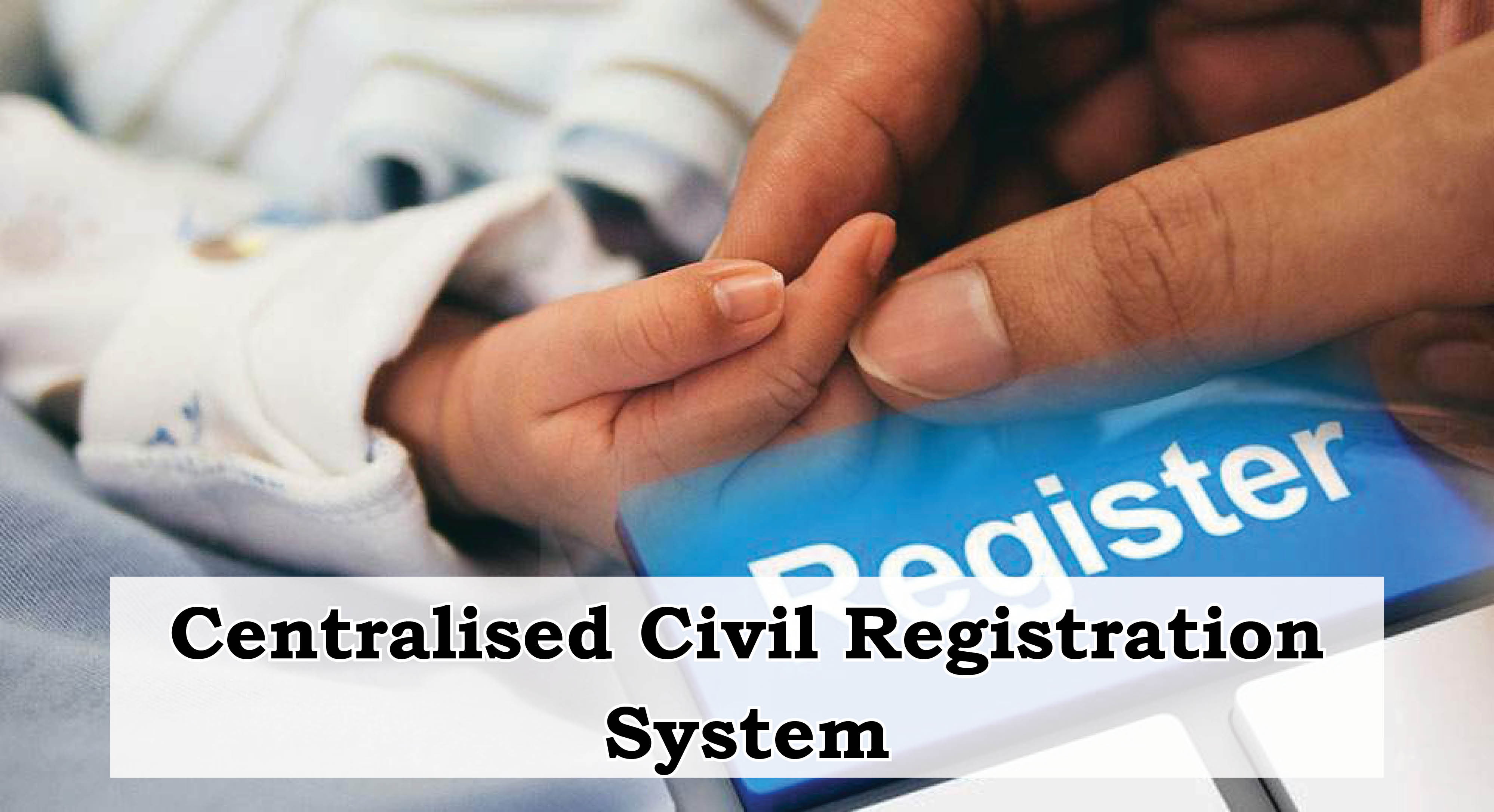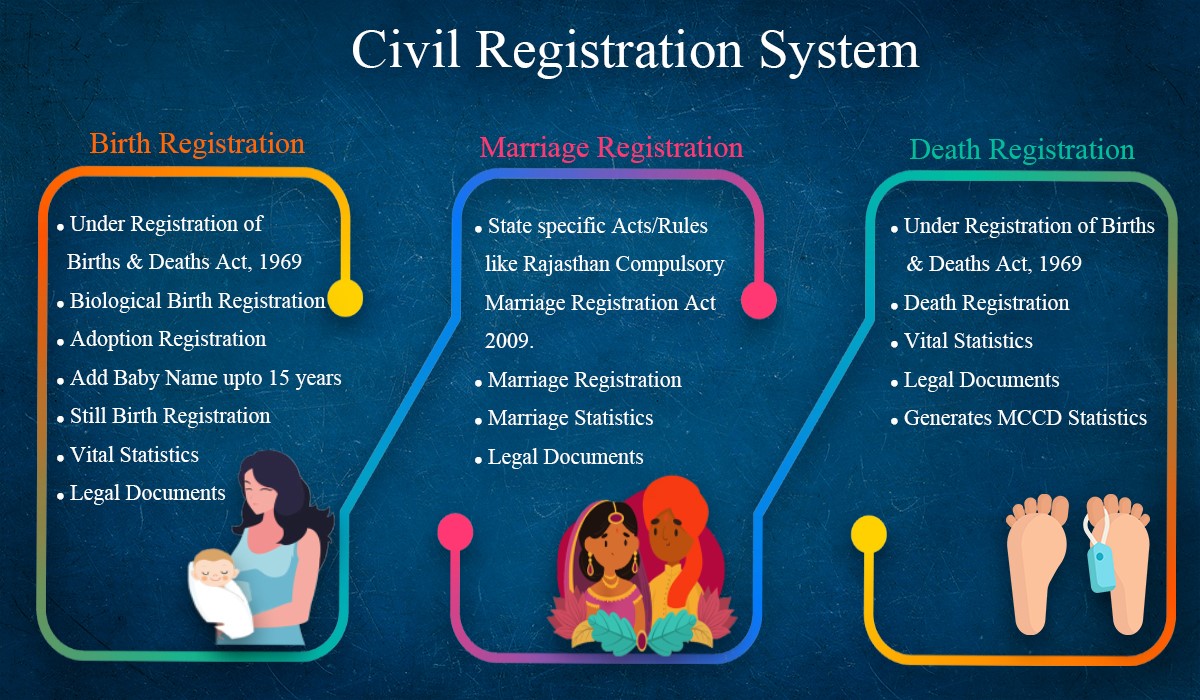Introduction-
The Office of the Registrar General of India (RGI), under the Union Ministry of Home Affairs, issued a critical directive on March 17, 2025, emphasizing strict adherence to the mandatory registration of births and deaths. The move comes in light of continued violations by both private and government hospitals, which are failing to comply with existing legal requirements. The circular underscores the government's commitment to achieving complete registration under the Civil Registration System (CRS) and addresses systemic gaps in reporting and documentation.
Current Status of Birth and Death Registration in India
- According to the RGI's latest circular, around 10% of birth and death events still go unregistered in India. Although the country has made notable progress—achieving a registration rate of 90%—the target of 100% universal registration remains unmet. The situation reflects significant improvement from 2011, when the registration levels were recorded at 82.4% for births and 66.4% for deaths.
- This progress aligns with the objectives of the Registration of Birth and Death (RBD) Act, 1969, which mandates the registration of all such events. Following its 2023 amendment, the law now includes stronger punitive provisions. Section 23(2) of the Act specifies that negligence by registrars in registering births or deaths is punishable with a fine, which was increased from ₹50 to ₹1,000 under the amended law.
Responsibilities under the Civil Registration System
The Civil Registration System (CRS), managed by the RGI, delegates responsibilities differently across the public and private healthcare sectors:
- Government hospitals act as registrars and are mandated to register events occurring in their jurisdiction.
- Private hospitals are expected to report events to the appropriate registrars so that certificates can be issued efficiently.
At the state level, the responsibility of registration varies:
- Health departments manage registration in states and UTs such as Assam, Chandigarh, Haryana, Lakshadweep, Meghalaya, Odisha, Punjab, Sikkim, and the Andaman and Nicobar Islands.
- In Kerala, the registration is overseen by the panchayat department.
- In Bihar, it is handled by the directorate of economics and statistics.
The 2023 amendment to the RBD Act also made it obligatory for Chief Registrars and Registrars to share data with the Centre, which will be consolidated into a national database managed by the RGI.
The Registration of Birth and Death (RBD) Act, 1969
The RBD Act, 1969, serves as the legal foundation for the compulsory registration of all births and deaths in India. The Act was amended in 2023 to strengthen enforcement, introduce digital reforms, and enable integration with national databases.
Mandates and Provisions:
- Compulsory Registration: All births and deaths must be registered with designated authorities.
- Responsibility of Registrar: Under Section 23(2), registrars are legally bound to register these events. Failure to comply invites a fine of up to ₹1,000, revised from ₹50 in the amended Act.
- Digital Reforms: As of October 1, 2023, all registrations are conducted through a centralized Civil Registration System portal, which is now the only official channel for obtaining digital birth and death certificates.
- Utility of Digital Certificates: A digital birth certificate is now the sole valid document for proof of date of birth required in services like school admissions, employment, passport issuance, marriage registration, and others.
Centralized Digital Registration and Its Implications
From October 1, 2023, all births and deaths in India are required to be digitally registered through the Centre’s Civil Registration System (CRS) portal. A key feature of this change is the introduction of digital birth certificates as the sole valid proof of date of birth for official purposes such as:
- Admission to educational institutions
- Government job applications
- Marriage registration
- Updates to NPR, ration cards, property registration, and electoral rolls
This move is also aligned with the updating of the National Population Register (NPR), which contains records of 119 crore residents. While the NPR is the preliminary step toward the National Register of Citizens (NRC) under the Citizenship Act, 1955, its update remains on hold due to the indefinite delay of the upcoming Census.
Challenges and Observations by the RGI
- Some hospitals delay registration until approached by the deceased’s or newborn’s relatives.
- Certain private hospitals avoid reporting events to registrars altogether, shifting the responsibility to families.
- Inadequate measures by some registrars to simplify the registration process for citizens were also noted.
- The RGI emphasized that birth and death certificates should ideally be issued within seven days of the event.
Vital Statistics and the Lack of Updated National Data
Another concern pertains to the Vital Statistics of India report, which has not been published at the national level since 2020. This report, crucial for:
- Public health policy
- Socio-economic planning
- Monitoring of social sector schemes
It is a compilation of state-level data on infant mortality, still-births, and overall deaths.
While states like Himachal Pradesh, Karnataka, Delhi, Chandigarh, Mizoram, Goa, and Arunachal Pradesh have published reports till 2022, Mizoram is the only state to have released its 2023 report. In contrast, Kerala’s last published report dates back to 2021.
According to the 2020 national report, notable trends included:
- A decline in registered births from 2.48 crore (2019) to 2.42 crore (2020) (a 2.4% decrease).
- An increase in registered deaths from 76.4 lakh (2019) to 81.2 lakh (2020).
- The decline in birth registrations was observed across most states, with the exception of Bihar, Haryana, Madhya Pradesh, Rajasthan, Sikkim, Andaman and Nicobar Islands, Jammu and Kashmir, and Ladakh.
About Registrar General of India (RGI)
The Office of the Registrar General of India is a vital institution functioning under the Ministry of Home Affairs. It was established in 1949 with the primary mandate of collecting, managing, and publishing vital population statistics for informed policy-making.
Key Functions:
- Conducts the Census of India, one of the world’s largest demographic data-gathering exercises.
- Oversees the Linguistic Survey of India, documenting the linguistic diversity of the country.
- Administers the Civil Registration System (CRS), ensuring the continuous recording of births, deaths, and stillbirths.
Conclusion
The March 17 circular by the RGI serves as a critical reminder of the importance of accurate and timely registration of vital events in India. While the digitization of records and the centralized CRS portal mark significant steps towards universal registration, systemic lapses in compliance, lack of updated data, and inconsistent implementation across states remain pressing concerns. Effective monitoring, stronger inter-departmental coordination, and citizen-friendly procedures are imperative for ensuring a robust civil registration infrastructure that can support both governance and public welfare.
| Main Ques- “Vital statistics play a critical role in public health policy and socio-economic planning.” In light of this statement, critically analyze the implications of the delay in the publication of the national Vital Statistics of India report since 2020. |










